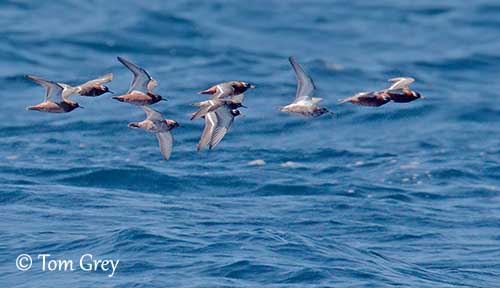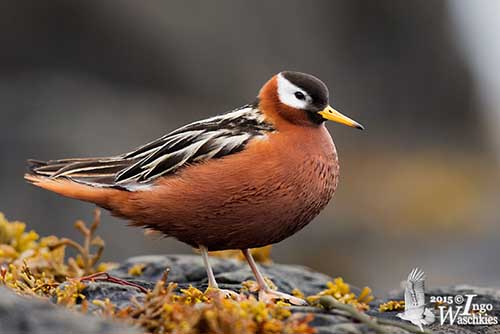
Fr: Phalarope à bec large
Ang: Red Phalarope
All: Thorshühnchen
Esp: Falaropo Picogrueso
Ita: Falaropo a beccolargo
Nd: Rosse Franjepoot
Sd: Brednäbbad simsnäppa
Photographers:
Tom Grey
Tom Grey's Bird Pictures
Otto Plantema
Trips around the world
Ingo Waschkies
Bird Photography
Nicole Bouglouan
PHOTOGRAPHIC RAMBLE
Text by Nicole Bouglouan
Sources:
HANDBOOK OF THE BIRDS OF THE WORLD Vol 3 by Josep del Hoyo-Andrew Elliott-Jordi Sargatal - Lynx Edicions - ISBN : 8487334202
SHOREBIRDS by Peter Hayman, John Marchant and Tony Prater – Christopher Helm – 1986 – ISBN: 0747014035
THE HANDBOOK OF BIRD IDENTIFICATION FOR EUROPE AND THE WESTERN PALEARCTIC by Mark Beaman, Steve Madge - C. Helm - ISBN: 0713639601
Bird Web (Seattle Audubon Society)
What Bird-The ultimate Bird Guide (Mitchell Waite)
Wikipedia, the free encyclopaedia
Alaska Department of Fish & Game
Red Phalarope
Phalaropus fulicarius
Charadriiformes Order – Scolopacidae Family
INTRODUCTION:
The Red Phalarope is rarely seen inland. It is marine and pelagic outside the breeding season, and breeds on the marshy tundra. The migration routes are entirely oceanic, and the birds usually fly between 80 and 160 kilometres offshore.
Phalaropes are known to reverse the usual sex roles in birds. The female is larger with brighter plumage than male. She leaves the incubating male and may sometimes find a second mate, involving a second clutch.
Breeding occurs in the high Arctic, but they winter in flocks on Southern Oceans.

DESCRIPTION OF THE BIRD:
Biometrics:
Length: 20-22 cm
Wingspan: 37-40 cm
Weight: 37-77 g
The Red Phalarope adult female in breeding plumage has bright chestnut neck and underparts. The streaked upperparts including mantle, scapulars and tertials are blackish-brown with pale cinnamon-buff fringes. We can see a white wingbar on the upperwing, more visible in flight. The rump is greyish and slightly tinged rufous at sides. The tail is grey with darker central rectrices. Underwing and axillaries are white.
On the head, crown, forehead, chin and area around the base of the bill are blackish-brown. Head sides, including eye’s area, are white. Centre of nape is grey.
The fairly long and broad bill is yellow with black tip. The eyes are dark brown. The legs are yellowish-brown. The toes have large, rounded, yellowish lobes.
The male in breeding plumage resembles female with duller appearance overall. Crown and mantle are streaked and the white on face is mostly buffy-white. The underparts are duller too, with indistinct white spots and markings.
In non-breeding plumage, both adults have blue-grey upperparts and white underparts. On the head, the hind crown is black, like the eye-patch extending to the ear-coverts.
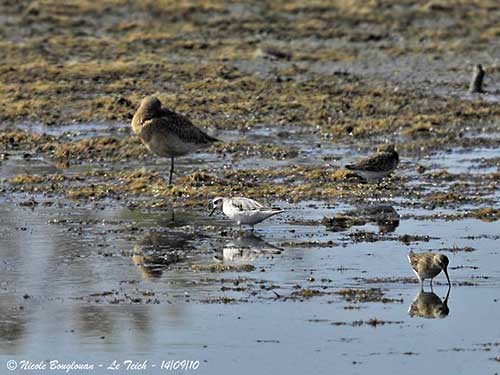
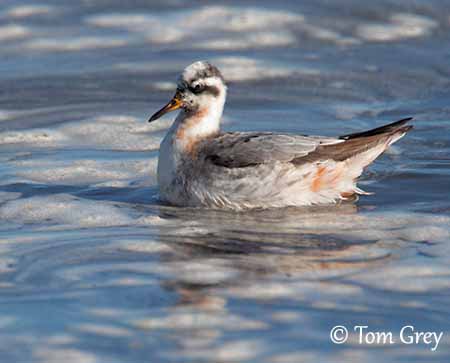
The juvenile is a mix of breeding and non-breeding adult plumages, with upperparts like the breeding male, and head pattern as non-breeding adult but browner. Neck and breast sides are pink-buff. The belly is white.
RANGE:
The Red Phalarope breeds on the coasts of the Arctic Ocean in Alaska, Canada, W Greenland, Iceland, Bear Island, Svalbard, Novaya Zemlya, C and E Siberia.
It winters at sea, mainly off W South America and W and SW Africa. They are less numerous in America, N to California, and in CW Atlantic, N to North Carolina.
HABITAT:
The Red Phalarope breeds by small pools in coastal tundra and boggy meadows with moss and grass, but usually on low-lying wet tundra near the coast.
Outside the breeding season, it is found at sea and often far from land. It frequents upwelling areas with high concentration of food.
However, the birds may sometimes reach coastal bays and marshes, and even inland lakes and reservoirs while driven by strong winds.
CALLS AND SONGS: SOUNDS BY XENO-CANTO
The Red Phalarope’s usual call is a short, explosive “pik” or “wit” also given in flight. On the breeding grounds, they give twittering and chirruping calls, and a rolling “prrrt”.
BEHAVIOUR IN THE WILD:
The Red Phalarope feeds on various invertebrates during the breeding season, such as insects and their larvae, and dipteran flies, caddisflies, beetles and bugs. It also takes molluscs, crustaceans, aquatic worms and spiders, and sometimes seeds when other food items are limited. It feeds on seaweeds (Fucus) around pools and lagoons, but also at sea.
During the breeding season, the Red Phalarope forages by swimming, wading and walking. On land, it walks slowly along the water edge. It uses its broad bill to seize the preys on or just below the water surface. It also uses upending with immersed bill or part of the head, and catches flying insects.
Outside the breeding season, it feeds at sea on plankton, small amphipods and small fish, taken from the surface or just below. They often gather around cetaceans that drive preys to the surface, and they may pick parasites from their backs too. While feeding, the birds often ingest floating plastic particles.
Outside breeding, they can be found in small flocks of about 20 birds, but occasionally, they gather in large flocks of several thousands. But usually, they are mostly found singly or in small parties.
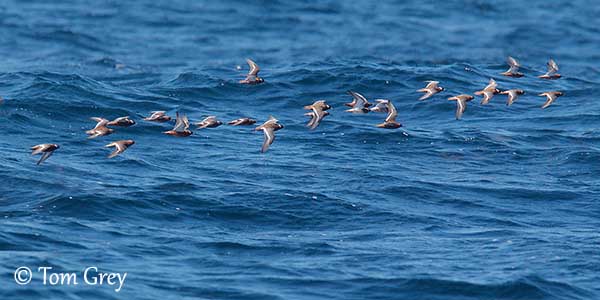
During the breeding season, the Red Phalarope reverses the usual sex roles, and the female performs courtship displays, flying in wide circles while calling. She chases the male in flight or pursues it on water, with head hunched down between the shoulders.
After mating, male and female make scrapes in the ground and the female selects one for the laying. The male finishes the nest-building by adding the lining.
The Red Phalarope follows exclusively sea routes during migration. Females leave the breeding grounds in early June, whereas adult males and juveniles leave mostly in late July to August.
They move southeast across Atlantic and Pacific Oceans, and reach their main wintering grounds off Chile and W Africa.
The Red Phalarope performs rapid and fluttering flight action. The flight is fast and direct with rapid wingbeats.
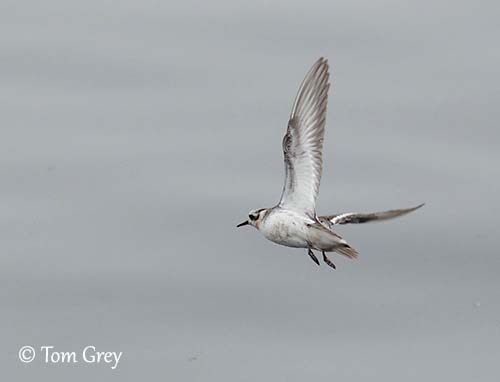
REPRODUCTION OF THIS SPECIES:
The Red Phalarope breeds during the summer. It breeds on marshy tundra near shallow pools and mainly on tundra covered in sedges of genus Carex.
The nest is a shallow scrape lined with grass, stones, lichen and feathers.
The female lays 3-4 eggs at 24 hours intervals. A replacement clutch can be laid after nest failure. The female leaves the male to care for the eggs, and she may sometimes find a second mate. The male incubates alone during 18-20 days.
At hatching, the chicks have cryptic plumage with cinnamon-buff upperparts with black and white markings, and pale greyish underparts with some white on breast and buff on flanks.
The young are independent just before fledging, 16-20 days after hatching. They are able to walk, run, swim and find food soon after hatching. They move in large flocks to larger lakes. They can breed at one year old.
The usual predators are foxes, weasels, jaegers, gulls and owls.
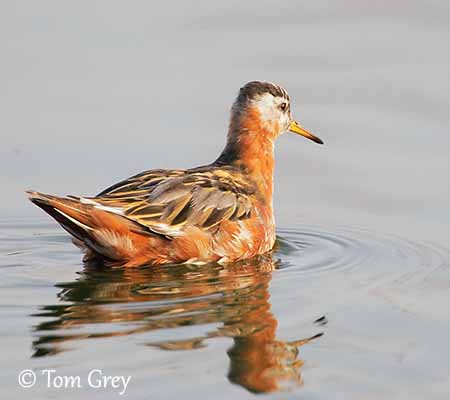
PROTECTION / MENACES / STATUS:
The Red Phalarope has large range and is not globally threatened. The global population is estimated to number 1,100,000 / 2,000,000 individuals. It is suspected to be declining, but few precise data are available.
The Red Phalarope is currently evaluated as Least Concern.
